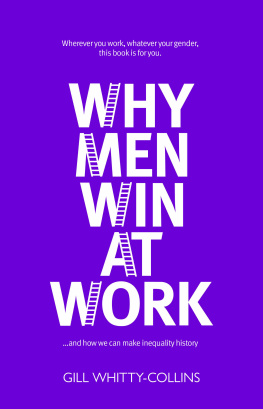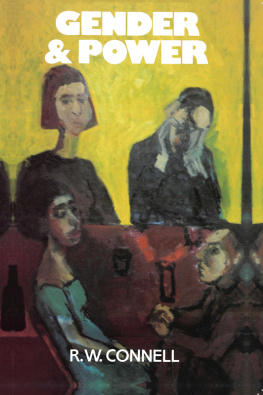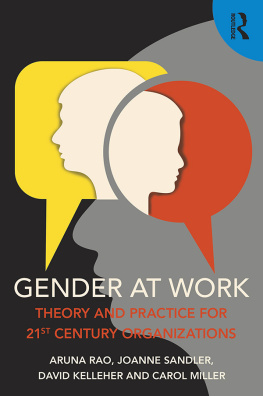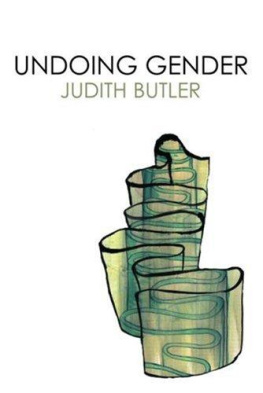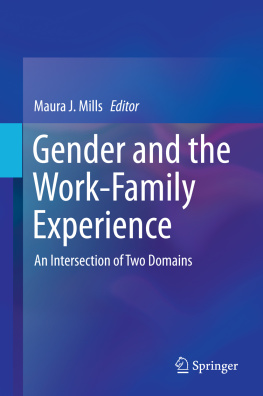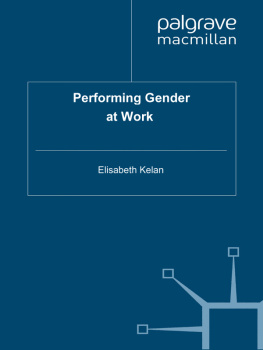First published 1983 by Allen & Unwin
Published 2020 by Routledge
2 Park Square, Milton Park, Abingdon, Oxon OX14 4RN
605 Third Avenue, New York, NY 10017
Routledge is an imprint of the Taylor & Francis Group, an informa business
A. Game and R. Pringle 1983
Cover painting Vivian Lynn
All rights reserved. No part of this book may be reprinted or reproduced or utilised in any form or by any electronic, mechanical, or other means, now known or hereafter invented, including photocopying and recording, or in any information storage or retrieval system, without permission in writing from the publishers.
Notice:
Product or corporate names may be trademarks or registered trademarks, and are used only for identification and explanation without intent to infringe.
National Library of Australia
Cataloguing-in-Publication entry:
Game, Ann.
Gender at Work.
Bibliography.
Includes Index.
IBSN 0 86861 253 7.
ISBN 0 86861 261 8 (pbk.).
1. WomenEmploymentAustralia.
2. Sex discrimination in employmentAustralia.
I. Pringle, Rosemary. II. Grace, Helen.
III. Title
331.4 1330994
Library of Congress Catalog Card Number: 82-83578
Phototypeset in Linotron 202 by
Graphicraft Typesetters Hong Kong
ISBN-13: 9780868612614 (pbk)
THIS book, Gender at Work, makes a definitive contribution to feminist theory concerning women in the labour force in the period since World War II. I had the pleasure of reading the work in progress and now have the honour of writing a foreword. My own research goes back to the turn of the century and the pattern has changed very little. The general standard of living has gone up but the change in womens status has been slight.
Moral, social and legal codes have been based upon myths and traditions which had scant relevance to reality but have served to reinforce power. In the last 20 years women have been searching for evidence, exploding myths and rewriting history which had mostly ignored the role of women. Gender at Work will be welcomed for its enormous significance to activists and theoreticians alike. It was a courageous undertaking to examine current practices in the workforce especially the effects of modern technology. A great need has existed for such a reference book.
Four main precepts have determined womens condition in the workforce. First, womens skills have been denied. Secondly, women have been regarded as invaders of the workforce. Thirdly, there is the paternalism of working men, employers and the courts. Finally, the segregation of the sexes at work has made it easier to deny women equitable pay.
Taking the first, I wince at the word deskilling, implying as it does that the only skilled work is that which has been labelled as such. What is skill? In workforce practices skill is that which has been recognised as such by masters and men. Male gender decided. This decision had been reinforced by formal apprenticeship available to males only, thus preserving not only the status of the occupation but its male line of succession. Work performed by a female automatically failed to qualify as a trade. Men who did ironing were called pressers and considered highly skilled. Women who ironed for a living were unskilled. The sexes never worked together in this occupation. Where the sexes did work together, for example in tailoring, a male coathand was considered far superior to a female coathand. When a white man developed manual dexterity, it became a skilled trade, when a woman or a black developed manual dexterity, it was a natural characteristic and classified as unskilled. The Negro tobacco stemmers in Virginia and the women stemmers working for W.D. & H.O. Wills in Britain, would have been surprised that white male tobacco stemmers in Sydney in the early 1900s considered themselves tradesmen and formed a craft union. My sister sewing pintucks at speed used as much precision and skill as a fitter tempering a piece of steel. Every occupation requires skill. Even in shovelling dirt or digging trenches, there is an enormous difference between the expert and the novice. Women in office work were denied their skill. We paid for training at business college where a good standard of spelling and grammar was required to learn typing and shorthand. When we worked in an office, every male was superior to us even if they had received no training.
Trades that have been so recognised are now threatened with deskilling by technological change, but the degree of skill which remains or the degree of new skill required to operate with the changes, are moot points which will be decided by a number of factors-the case put up by the union advocates, the supply of labour available and traditional values.
Examples in the trades illustrate the way in which women were swindled in the past in recognition of their skill. Tailoring was the only trade wherein women held the status of journeywomen. They were never paid the rate of journeymen, even when doing the same work. After two years women could become trouserhand or vesthand, and after three years, coathand. That was as far as they could go. Males served a five year apprenticeship which added cutting and pressing to the tailoring. Men preserved the skills of cutter, presser and tailor as exclusive male dominions. No matter how good they proved to be, and they were quicker at sewing than the men, it was absolutely untenable that women should receive the same wages as men. The price of labour was determined by sex, not by the value of the work, nor the competence of the worker.
In Sydney in 1890, by agreement between the journeymen tailors and the employers, a tailor was permitted to have two journeywomen working under his supervision and adding to his status. He received an additional bonus in his pay on their output. By 1904 the ratio crept up to one tailor to six tailoresses who were no longer apprenticed. Men had resisted what they considered the invasion of women but the employers wanted them because they were cheaper. There was a constant battle to fix a ratio of females to males but in the clothing trade the men did not succeed. They kept women down in the trade but not out of the industry.
In the boot trade women were also denied their skill. At the Royal Commission on Strikes held in Sydney in 1890, shoemaker George Garton gave evidence. He told the Commission that most footwear had been imported in the early days of the colony, but whatever footwear had been made here had often been done by women in the home. The husband/father, as had been the custom in England, bought the material and equipment, chased after orders, measured the customer, made the delivery and collected the money, whilst the wife and daughters made the boots. The witness, himself a good tradesman, said the women were more skilled than most men in the trade. When boot factories mushroomed in Sydney and Melbourne, women received no recognition for their skill. They were prevented from performing certain parts of the trade and restricted to specific operations delegated to them by the male workers and agreed to by factory owners. Women were used as complementary assistants to skilled male operatives.
The second precept, that working women were regarded as interlopers and men did not want them in the workforce, is demonstrated by a case before the NSW Industrial Arbitration Court in 1907 concerning the boot trade. Three separate craft unions (males) made a combined claim to the Arbitration Court: they were the Boot Operators and Rough Stuff Cutters Union, the NSW Clickers Union and the Boot Trades Union of NSW. The advocate was the rising star, George Stephenson Beeby, Women were working in the same factories as the men so that men union members had every opportunity to entrol the women if they wanted to. Lest any doubts linger that women were not wanted, I quote Beeby himself from the court transcripts:




